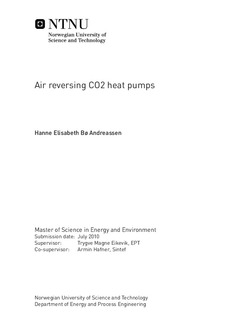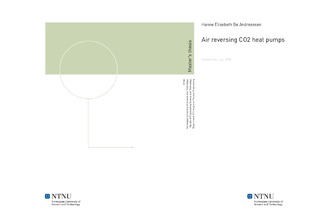| dc.contributor.advisor | Eikevik, Trygve Magne | nb_NO |
| dc.contributor.advisor | Hafner, Armin | nb_NO |
| dc.contributor.author | Andreassen, Hanne Elisabeth Bø | nb_NO |
| dc.date.accessioned | 2014-12-19T13:52:14Z | |
| dc.date.available | 2014-12-19T13:52:14Z | |
| dc.date.created | 2010-10-01 | nb_NO |
| dc.date.issued | 2010 | nb_NO |
| dc.identifier | 354376 | nb_NO |
| dc.identifier | ntnudaim:5724 | nb_NO |
| dc.identifier.uri | http://hdl.handle.net/11250/256886 | |
| dc.description.abstract | CO2 is an environmentally friendly refrigerant that has a no global warming potential when used as refrigerant. The current refrigerants used for air conditioning in public transport are chemical components, and have a high global warming impact. The possibility of replacing the conventional refrigerants by CO2 is investigated for various parts of the transport sector. A possible CO2system for heating and cooling for public transport has been modeled and simulated. This system is a turntable prototype which is reversing the airflows to provide either cooling or heating. It has two gascoolers and two evaporators for separate treatment of ambient and recycled air. The plate is rotated 180˚ to switch from heating to cooling mode. CO2 has large potential for expansion work, due to the normally large throttling losses for high ambient temperatures. An ejector has therefore been implemented in the heat pump circuit. The turntable prototype is modeled by the simulation tool Modelica, and it is investigated how this ejector system adjusts to varying ambient conditions and power demand. Weather data from the climate database Meteonorm was used as a basis for calculation of heating and cooling demand for a train compartment in five different cities, covering a variety of climates. A case study was performed based on an occupancy rate profile and operative hours of the heat pump for the compartment. Simulations were performed of the air reversing heat pump based on the heating -and cooling demand calculations for the five cities. The COP values obtained are very positive, and they are in general higher for heating than cooling mode. The COP is depending on the load, and decreases with reduced occupancy rate. For cooling mode the COP ranged from 3.1 to 6. For heating mode it ranged from 8.2 to 2.8. With the occupancy rate chosen, the annual energy savings is about 80% for all the 5 cities of the study. The fan work of the heat pumps was also included for 4 different operating modes. This reduced the total COP by between 10 to 40%, depending on heating and cooling power requirement and ambient conditions. The fin and tube gas coolers that were used in the Modelica model were compared to a set of MPE gas coolers. The total mass of the heat exchangers was reduced by 50%. One would still have to weigh the reduced mass and increased LCCP performance against the increased investment cost of the MPE heat exchangers. | nb_NO |
| dc.language | eng | nb_NO |
| dc.publisher | Institutt for energi- og prosessteknikk | nb_NO |
| dc.subject | ntnudaim:5724 | no_NO |
| dc.subject | SIE5 energi og miljø | no_NO |
| dc.subject | Energibruk i bygninger | no_NO |
| dc.title | Air reversing CO2 heat pumps | nb_NO |
| dc.type | Master thesis | nb_NO |
| dc.source.pagenumber | 109 | nb_NO |
| dc.contributor.department | Norges teknisk-naturvitenskapelige universitet, Fakultet for informasjonsteknologi, matematikk og elektroteknikk, Institutt for elkraftteknikk | nb_NO |

